5. Comparing the Most Popular Social Media
In this chapter, you discover the most popular social media in use today.
I’ve talked a lot about Facebook, Pinterest, and Twitter, but there are a lot more social media than just these, and they all service slightly different purposes and user bases.
Examining Different Types of Social Media
Social media are those websites, services, and platforms that people use to share experiences and opinions with one another. They cover everything from social networks, where users share the details of their own lives, to social bookmarking services, where users share sites and articles they like.
Social Networks
The first type of social media is the social network. Social networks are unquestionably the most popular type of social media in use today.
A social network is a large website or service that hosts a community of users and facilitates public and private communication between those users. Social networks enable users to share experiences and opinions with each other via short posts or status updates.
Some social networks, such as school or alumni networks, are devoted to a specific topic or community. Other social networks, such as Facebook, are more broad-based, which allows for communities within the overall network to be devoted to specific topics.
Because of their multi-faceted offerings, social networks appeal to a broad base of users. Young and old people alike use social networks, as do people of all genders, races, and income and education levels. Social networks help us keep up to date on what our friends are doing and keep our friends updated on what we are doing. Social networks also help establish a sense of community based on shared experiences at school, in the workplace, or at play.
Most social networks revolve around users’ posts or status updates. Users keep their friends informed of current activities via these short text or picture posts and read updates posted by friends via some sort of news feed. Everybody keeps up to date with what everybody else is doing.
Many social networks also offer other means of user-to-user communication, including private email and one-to-one instant messaging. Most social networks also include various forms of media sharing, including digital photographs, videos, and the like.
The most popular social networks today are Facebook (www.facebook.com) and LinkedIn (www.linkedin.com).
Media Sharing Networks
A media sharing network like Pinterest or Instagram is a social network that focuses on images instead of text messages. There is less one-to-one communication and more general photo and video sharing. A media sharing network is like Facebook without all those bothersome words and sentences.
In a media sharing network, users post their own photos and videos or links to images on various web pages. Their friends and followers then view, comment on, and share those posts with other people. The most popular images go viral and are shared by thousands of interested users.
Because we’ve evolved into a very visual society, media sharing networks are becoming increasingly popular, particularly among users of mobile devices. It’s easy to snap a picture with your smartphone and then post it to your network of choice. (For that matter, photo sharing on general social networks, such as Facebook and even Twitter, has become a very big part of the overall social experience.)
The most popular media sharing social networks today are Pinterest (www.pinterest.com) and Instagram (www.instagram.com).
Microblogging Services
When you separate the short text messages or status updates from a social network into a separate feed, you have a microblogging service. Some microblogs, such as Twitter, exist primarily to distribute short text posts (and the occasional photo) from individual users to groups of followers; other microblogs, such as Tumblr, are more focused on posting images and longer text-based content.
Microblogs do not offer many of the community features found on larger social network sites. Most microblogs don’t offer topic-based groups, photo storage and sharing, and the like. The primary service they offer is public message distribution.
With a typical microblogging service, registered users post short text messages, photos, or videos. Other users sign up to follow the posts of individual members and receive notifications when someone they follow makes a new post. Microblog posts are used to convey personal information and opinions; businesses also use them to make commercial announcements.
Many of the most-followed microbloggers are celebrities; fans follow their posts to learn more about the celebrities’ activities. Major news organizations also use microblogs to post breaking stories, whereas individuals post details of their personal lives to interested friends and family followers.
The most popular microblogging services today are Twitter (www.twitter.com) and Tumblr (www.tumblr.com).
Message Boards
Many websites offer online message boards where users can interact by leaving their comments about particular articles or general topics. You can find message boards or comments sections on many general-interest and news-oriented sites, as well as on sites that focus on specific topics.
A message board is a public forum. Users can start a new topic or comment on an existing one. Comments are organized into threads, with each successive user adding his comments to those comments left by previous users. It’s not real-time interaction, but it is a continuing discussion.
The advantage of frequenting a given site’s message board as opposed to using a larger, more general social network is that you know you’re interacting with people who like the same things you do. Message boards create a community of like-minded users, not unlike a traditional club or group, but not limited by physical boundaries. If you’re a model kit builder, for example, a kit-building message board helps you keep in touch with kit builders from around the world.
Message Boards
Learn more about message boards in Chapter 17, “Getting Social on Special Interest Message Boards.”
>>>Go Further: Reddit
There’s one social media site that doesn’t fit cleanly in any of these buckets. Reddit (www.reddit.com) is a social website that lets users aggregate online content and facilitates discussion about that content. It’s not really a social network; it’s more like a collection of message boards organized around specific topic areas.
As such, the Reddit site is a hotbed of lively online conversation between users—such a hotbed that the site generates a lot of controversy. In fact, Reddit conversations are often so unruly—and sometimes vicious—that the site can be downright unfriendly to more genteel users. This is probably one reason why Reddit isn’t widely used by older adults—although it’s popular among many younger, more vocal users.
Discovering the Top Social Media for Older Users
Of all the various social media available today, which should you be interested in? The answer, as you might suspect, is that it all depends.
You need to choose your social media based on what you’re interested in and who you want to stay in touch with. For example, if you just want to stay in touch with your cousin Emily and her family, or the neighbors from your old neighborhood, or the folks you go to church with, then a general social network such as Facebook is the right choice. If, on the other hand, you want to keep in contact with your old business associates, then LinkedIn’s professional networking makes more sense. If you like to share pictures of recipes and do-it-yourself (DIY) projects, consider Pinterest. Or if you want to stay hip with what your younger children or grandchildren are up to, then the youth-oriented Twitter is the place to be.
That said, some social media have more appeal to older users than do others. The following graphic details the percentage of online users aged 50 to 64 who use various social media.
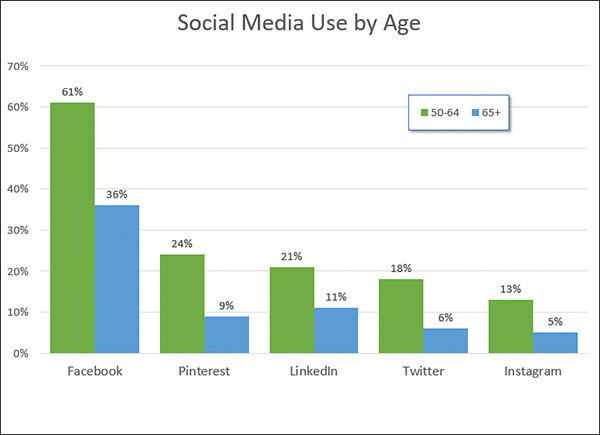
Statistics provided by the Pew Research Center’s Internet Project for the year 2016
As you can see, Facebook is definitely the big dog among more mature users. If you only use one social medium, that’s the one. But LinkedIn and Pinterest—and even Twitter and Instagram—also have appeal and might be worth considering. Let’s a take a quick look at what each of these social media have to offer.
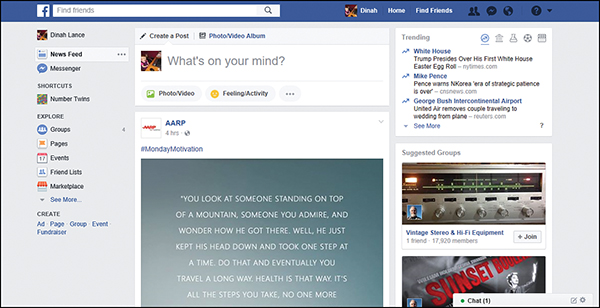
There are lots of reasons why Facebook (www.facebook.com) is used by the majority of online users over 50. It’s easy to use and doesn’t require a lot of technical or computer expertise. It’s big (more than 1.8 billion users each month), which means that most of your friends and family are already using it, so there are lots of people to interact with. And it offers a variety of features that help you connect or re-connect with people you know or used to know. In short, it’s the whole ball of wax in a very user-friendly package.
People use Facebook to keep their friends informed of their latest activities, as well as to keep in touch with what their friends are doing. The average adult Facebook user has more than 300 friends on the site and spends more than 50 minutes every day connected to the Facebook site.
Because of its general nature, Facebook is popular among people of all ages. Users range from grade schoolers (actually, the minimum user age is 13) to retired snowbirds—with the older generation making up most of the site’s growth in recent years.
In addition to posting and reading status updates, Facebook users have access to a variety of other community features. Facebook offers topic-oriented groups, pages for companies and celebrities, photo and video sharing, social games, instant text messages, one-to-one video chats, even live video broadcasting. Many people log onto Facebook in the morning and stay logged in all day—there’s that much to do there. And you can access all of Facebook’s features from your computer, smartphone, or tablet.
In short, Facebook is the premier social medium for online users of all ages—and especially for those over age 50.
Learn more about Facebook in Chapter 6, “Keeping in Touch with Friends and Family on Facebook.”
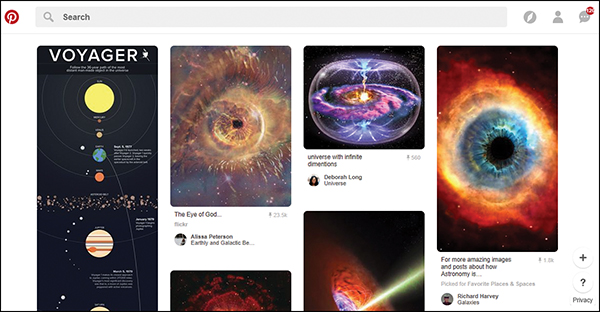
Pinterest (www.pinterest.com) has risen to become the number-two social medium among older users, used by nearly a quarter of those aged 50 to 64. In a way, Pinterest is like Facebook but with only pictures. Members use Pinterest to share photos and other images they find interesting with their family and online friends.
The way it works is you find an image from a website or another user, and then you “pin” that image to one of your personal boards on the Pinterest site. Other users see what you’ve pinned, and if they like it, they repin it to their boards.
A Pinterest board is like an old-fashioned corkboard, only online. Your boards become places where you can create and share collections of those things you like or find interesting. You can have as many boards as you want, organized by category or topic. It’s a way to collect images you like and share them with the wider Pinterest community.
Pinterest is unique among today’s social media in that it has been strongly embraced by women of all ages. More than 80% of Pinterest users are women, and a third are over age 40. Pinterest users are more likely to live in Midwestern states instead of the coasts, and two-thirds are firmly middle-class.
The visual nature of Pinterest makes it attractive to non-technical users. It’s the number-three social medium for older users, closely behind LinkedIn. If you’re into collecting or recipes or DIY projects, Pinterest has a lot to offer.
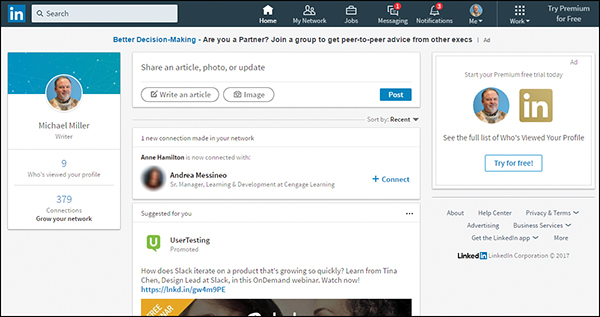
LinkedIn (www.linkedin.com) is a social network, like Facebook, but with a distinct focus on business. The site was launched in 2003 and currently has more than 467 million registered users. LinkedIn is the number-three social medium among users 50 to 64—and number-two among those 65 and older.
LinkedIn is used primarily by current and former business professionals for networking and job hunting. It’s a great place to keep in touch with current and former co-workers, as well as others in your profession.
About a third of LinkedIn users are at least 50 years old. That’s more than 100 million users aged 50 or older. Because of its professional focus, LinkedIn has a higher percentage of higher-income users than any other social media. Most LinkedIn users are successful in their chosen professions, with close to half describing themselves as “decision-makers” in their companies.
In addition, millions of companies have LinkedIn Pages in order to establish a strong industry presence. LinkedIn also counts among its members executives from all Fortune 500 companies.
People use LinkedIn to expand their list of business contacts, keep in touch with colleagues, give and receive professional endorsements, and keep abreast of developments in their profession. Contacts made on LinkedIn can be used for a number of different purposes, such as finding employment, making a sale, or exploring business opportunities. You can also use LinkedIn to gain an introduction to a specific individual you’d like to know, via connections with mutual contacts.
In short, if you’re a business professional, LinkedIn needs to be part of your social media portfolio. Compared to other social media, this one is serious.
Learn more about LinkedIn in Chapter 14, “Fine-Tuning Your Professional Profile on LinkedIn.”
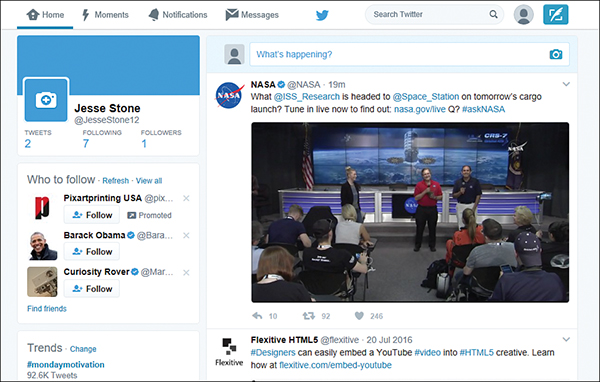
Twitter (www.twitter.com) is a microblogging service popular with people in their 20s and 30s and with those who like to follow celebrities and politicians. Users post short (140-character) text messages, called tweets, from their computers or mobile phones; a tweet can also include a web link, picture, or video. Tweets are displayed to a user’s followers and are searchable via the Twitter app or website.
Although Twitter gets a lot of media attention, it comes in as the fifth most-used social network for users of all ages, and number-four for users aged 50 to 64. Twitter currently has more than 300 million users each month who generate more than 500 million tweets each day. Only about a quarter of Twitter’s users are older than age 50, however; because it’s a bit more technically difficult to use, Twitter remains a social medium targeted at younger users.
Unlike Facebook, Twitter has few community-oriented features, which has also hindered the service’s mainstream acceptance. Twitter is a microblogging service, not a full-featured social network. With Twitter, you only get message posting and following; there’s no photo sharing or groups.
Given Twitter’s limitations, why do younger people like it so much? Like Facebook, some people use Twitter to inform friends and family of what they’re doing and thinking. Others use Twitter as a kind of personal blog, posting random thoughts and comments for all to read. Businesses use Twitter to promote their brands and products, making announcements via their Twitter feeds. Celebrities and entertainers (arguably the most-followed tweeters) use their Twitter feeds as a kind of public relations (PR) channel, feeding information of their comings and goings to their fan bases. As you’ve probably noticed, politicians (and presidents) also use Twitter to get their message out to the faithful. And news organizations use Twitter to dissect the tweets of the rich and famous and disseminate the latest news headlines.
That last bit is important. Although Twitter is not a formal news medium, in that it has no central organization or paid reporters, it has become an important medium for disseminating breaking news stories. Today, many major news stories are tweeted before they’re announced by the traditional news media, either by individuals on the scene or by reporters who can quickly tweet about an event before filing a lengthier news report.
So if you want to keep abreast of breaking news (both actual and celebrity-related), follow the pontification (or ravings) of your favorite politician, or just want to see what the younger generation is up to, give Twitter a spin. Otherwise, a more fully-featured social network, such as Facebook, is probably a better choice.

Instagram (www.instagram.com) is the fifth most popular social medium among users aged 50 to 64. Unlike the other social media discussed here, Instagram is strictly mobile-based; it’s essentially a media sharing network based on a mobile app for Apple and Android phones and tablets. You use the Instagram app to take pictures with the camera in your phone or tablet, and then you post those pictures to the Instagram network. The pictures you post are viewed by your friends and followers and then shared with their friends and followers.
Although Instagram has a website, it’s really mobile-based, as it relies on the pictures you take with your smartphone. In fact, some people use the Instagram app solely for taking pictures, as it offers a variety of filters and special effects to enhance the photos you take.
People use Instagram to visually document their lives. When you do something of interest, you snap a picture and post it to Instagram. Your friends do the same. You don’t need to read long, boring text posts—just look at pictures. There’s an appeal to that—especially among younger users. To that end, 59% of Instagram’s 600 million or so users are between the ages of 18 and 29; only 18% of all users are aged 50 and up.
Instagram’s users are quite active, posting more than 80 million photos a day. That makes Instagram one of the top photo-sharing services on the Internet—even without the social component.

